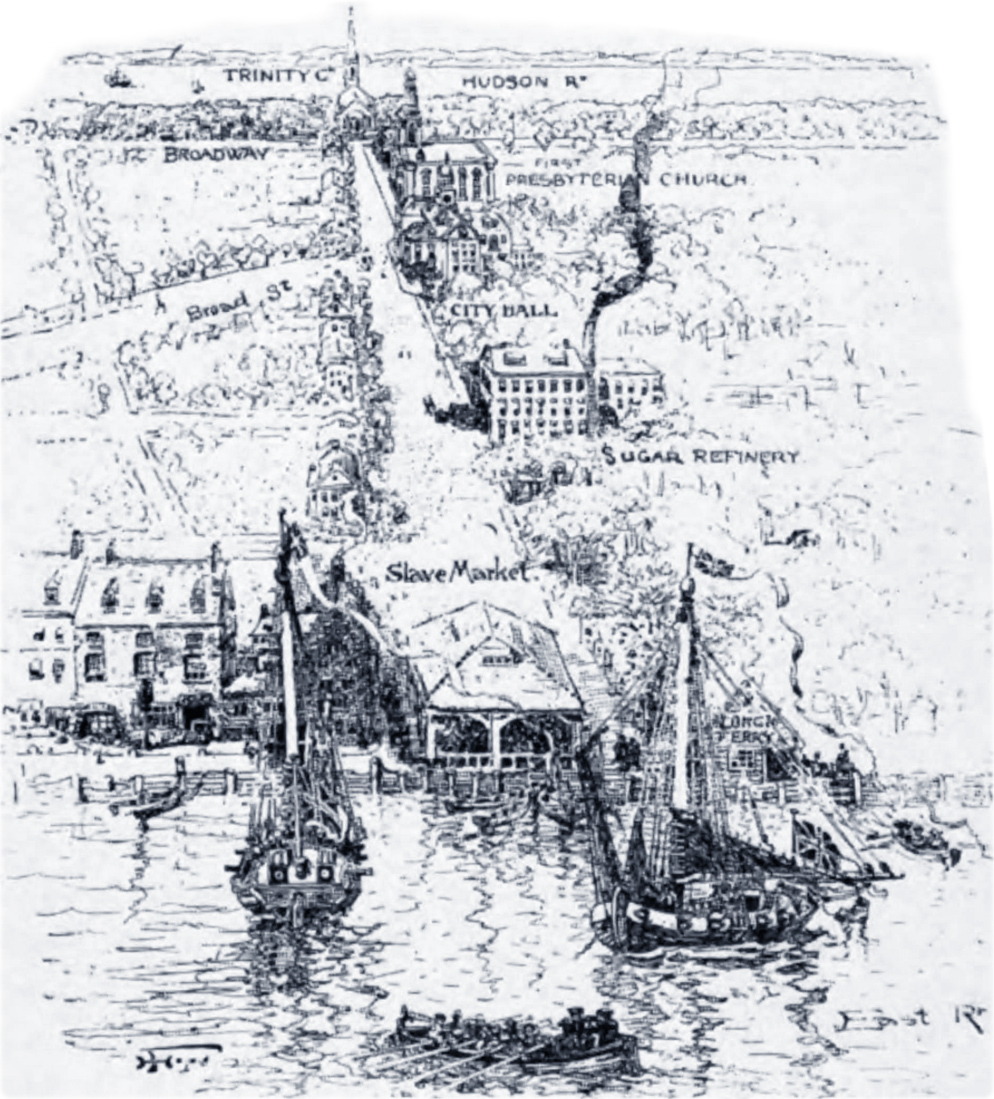
Wall Street - about 1735
Original title: Bird's-Eye View of Wall Street about 1735. Illustration published in the Harper's Monthly Magazine, May, 1908, in the Wall Street in Colonial Times by Frederick Trevor Hill. The original Trinity Church, on Broadway, facing Hudson River, is depicted in the distance. This engraving also represented the old City Hall, the First Presbyterian Church, Sugar Refinery, the Slave Market and Long Island Ferry. Here some text from the magazine related to this image:
«Had Captain Kidd [1654-1701] revisited Wall Street some three-and-forty years after he had become one of its pioneer proprietors, he would have found himself in strange surroundings, and it is not at all probable that he would have realized the dignity or importance of the thoroughfare from any external evidence. Indeed, the street presented in 1734 a decidedly ragged and unattractive aspect. At its eastern end or slip, in front of the Long Island Ferry, stood the flimsily constructed Meal Market, whose transactions in corn and similar merchandise had been supplemented by a more profitable traffic in negro slaves, who were daily displayed in its stands for the benefit of those desiring to buy, sell, or hire such commodities, and on either side of this unsavory mart stretched a broken line of mean little wooden buildings extending as far west as William Street. From this point the prospect gradually improved, the Broadway end boasting some dwellings of neat and attractive appearance, but the north side remained entirely vacant save for four wholly dissimilar structures. The first of these, on the northwest between William and Nassau streets, was the property of Gabriel Thompson, a tavernkeeper, beyond which loomed a huge barnlike affair erected by the Bayards, in 1729, for what they termed “the mystery of sugar refining” — a mystery which Wall Street has not wholly fathomed to the present day; and adjoining this crude factory stood the most pretentious building on Manhattan Island — the City Hall, whose foundations had been laid in 1699 with the stones taken from the bastions of the old palisade. Beyond this, and almost adjoining it, lay the Presbyterian church, a substantial brick edifice; and at the head of the street on Broadway squatted the ugly, square little wooden building with a disproportionately tall steeple which had sheltered the congregation of Trinity Church since 1696.
Such was the condition of the street which had in less than half a century acquired political if not social ascendency over all other thoroughfares of the city, which now boasted a population of nearly ten thousand souls. The most potent influence effecting this result had, of course, been the selection of the street as the site of the City Hall, for that building was not only the seat of government, but the social centre, New York in those days being ruled by an aristocracy whose nod made the laws and set the fashions. The presence of Trinity Church had likewise given the street a certain social prestige, for it had almost immediately become the semi-official place of worship, with a pew reserved for the Mayor, Recorder, Aldermen, and other dignitaries, and its list of parishioners included many of the most notable people in the community. In fact, when Messrs. In Fact, when Messrs. De Peyster and Bayard, who had purchased most of Governor Dongan’s queerly acquired holdings of the northern frontage, enabled the Presbyterian Church to obtain a broad foothold, practically all the spiritual and temporal power of the city lay concentrated on the narrow, unlovely highway. Under these circumstances it is not at all surprising that well to do families soon began to establish comfortable residences in proximity to the churches, that the mercantile and financial exchanges clustered along the site of the old canal to the very steps of the City Hall, and that that building became the scene of almost every event associated with the early history of the rising city.»

Wall Street - about 1735
|
Copyright © Geographic Guide - Images of NYC, Eighteenth Century. |
